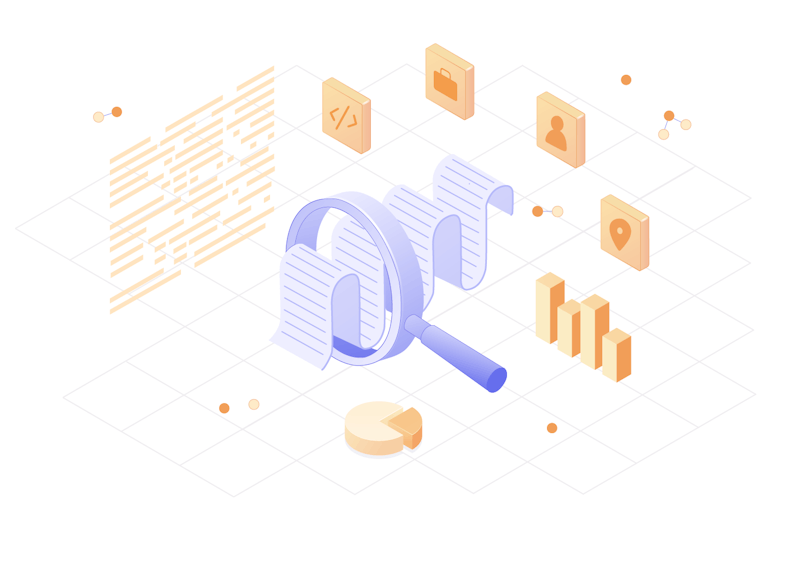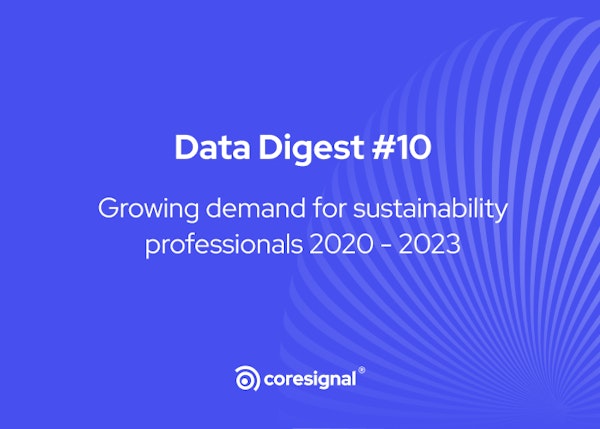Professional network data
Leverage our top B2B datasets
Job posting data
Get access to hundreds of millions of jobs
Employee review data
Get data for employee sentiment analysis
Clean dataNEW
Enhanced professional network data
Employee data
Get data on global talent at scale
Funding data
Discover and analyze funding deals
Firmographic data
Unlock a 360° view of millions of companies
Technographic data
Analyze companies’ tech stacks
BY INDUSTRY
MOST POPULAR USE CASES
Investment
Leveraging web data for informed investing
HR tech
Building or enhancing data-driven HR tech
Sales
Supercharging your lead generation engine
Marketing
Transforming marketing with web data
Market research
Conducting comprehensive market research
Lead enrichment
Use Coresignal’s data for enrichment
Talent analytics
Analyze talent from multiple perspectives
Talent sourcing
Comprehensive talent data for recruitment
Investment analysis
Source deals, evaluate risk and much more
Target market analysis
Build a complete view of the market
Competitive analysis
Identify and analyze competitors
B2B Intent data
Lesser-known ways to find intent signals
BY INDUSTRY
MOST POPULAR USE CASES
Investment
Leveraging web data for informed investing
HR tech
Building or enhancing data-driven HR tech
Sales
Supercharging your lead generation engine
Marketing
Transforming marketing with web data
Market research
Conducting comprehensive market research


Susanne Morris
July 28, 2023
Unlocking the power of data has become more and more popular among business experts and investors. With a proven track record, data has been shown to generate leads, provide insights, and predict market trends in a way never before seen.
Additionally, BI-Survey projects that 80% of the data-driven industries will utilize data discovery techniques over the next few years, meaning it is more important than ever for businesses to implement data governance to protect and organize their data, as well as polish their data management practices.
This is where data discovery comes into the picture.
What is data discovery?
Data discovery definition refers to the data collection process that involves gathering data from multiple databases and data sources, cataloging said data, and classifying the data for evaluation and analysis.
Data discovery empowers leaders to meticulously analyze business models and provides security and organizational solutions, among other things.
This article will explore the process of data discovery, its use cases, as well as the beneficial linkage between data discovery and data classification.
Let's start by taking a closer look at the data discovery process.
How Is data discovered?
Depending on the industry and the context, the process of data discovery may have slightly different definitions. In this article, we're discussing data discovery from the perspective of investment companies.
To put it simply, data is discovered by first identifying your business needs related to data, combining data from different sources and channels, and preparing it for analysis by cleansing and performing other fixes of incorrect and inconsistent data. After the preparation comes the analysis, and the cycle continues by recording the analysis and iterating.
The data discovery process
Similar to organization-based analysis processes, such as data aggregation, data discovery is an ongoing process that involves detecting patterns, outliers, and errors throughout large structured and unstructured datasets.
Ultimately, there are three main data discovery categories: preparation, visualization, and analysis. These steps continually work together to provide hidden insights, potential security breaches, and visual mapping.
1. Preparation
The first step is essential for a quality data discovery process. The data preparation phase rearranges the data so that the visualization and analysis portion of data discovery can run more smoothly.
Without preparation, the data will be too convoluted to properly uncover any hidden business insights. Data preparation essentially cleans and merges the data quality within the datasets being examined.
Today, there are many types of software that provide data preparation in addition to other discovery and classification tools.
These automated tools are able to erase outliers, unify data formats, detect null values, and standardize data quality.
2. Visualization
Once all of the data points have been transformed into a consistent and readable format the data then enters the visualization stage. For example, interactive data visualizations, that consist of many predefined templates for dashboard analysis, are one of the features of great data discovery tools.
Visual data discovery, also referred to as data mapping, displays the prepared data into visual formats such as charts, graphs, maps, etc. to provide business experts with broader insights and convenient platforms for visual analysis.
These visual guides, resulting from data mining, data preparation, and sorting, display the primary trends found in the dataset being processed.
Arguably, data visualization is the most important step for data discovery, as it is a foundational aspect of AI-based business intelligence.
3. Analysis
After the mapping and visualization process is complete, the data is then analyzed so it can be summarized and organized into a succinct readable format.
Oftentimes the analysis process involves summarization in the form of descriptions. It is important to note these descriptions aren't necessarily complete sentences that suggest consequential information.
Rather, instead of a spreadsheet, analysis aims to describe the implications of visualization and provides descriptive statistics that make the data more readable and almost story-like.
4. Repeat
Similar to other data analysis processes, data discovery is iterative. According to Forbes, nearly 90% of all data was created in the past few years, and this rate is expected to increase exponentially.
For businesses, this means that in order to unleash your data's potential this process must be repeated and built upon regularly.

Data discovery use cases
The main use cases for data discovery are fraud detection, social media analysis, data completeness, accessibility, compliance, business relationship insights, and lead generation.
Let's take a closer look at some of the more notable data discovery use cases.
Lead generation
By visually mapping data you are able to find insights that may not have been recognized before. Many sales and acquisition teams utilize data discovery for lead generation.
They can also combine customer data from multiple sources and generate relevant data insights that will enhance lead scoring and lead generation
Investment signals
Data discovery is essential for investors because it allows them to find new investment opportunities. In this case, data discovery revolves around finding and evaluating new startups to invest in. Investors can either conduct manual data discovery or resort to advanced data discovery solutions to generate investment signals.
Firmographic data is a great source of information for investors looking to find new companies. It allows you to easily discover new companies that might otherwise be beyond your scope of reach.
Data points such as company name, location, headcount, industry, revenue, and more open up the option to filter companies according to specific parameters and discover new investment opportunities that fit your ideal company criteria.
Remove the hassle of spending hours on end looking for new investment opportunities and let us present the required data for you. Furthermore, you won't need to worry about the validity and freshness of the company data. It's our primary goal to always keep the data fresh and accurate.
Data completeness
Today's understanding of data quality involves data completeness. Data completeness is realized during the preparation and analysis phases.
Compliance
Because of the broad analysis involved in data discovery, many businesses utilize the process to achieve data compliance with the GDPR (General Data Protection Regulation).
Data discovery methods
Similar to processes such as data normalization and competitive analysis, the data discovery process has been greatly improved by the rise of artificial intelligence and automated tools.
Let's take a look at the two methods of data discovery processes and the reason for the transition from manual to automated discovery.
Manual data discovery
Before the invention of automated data discovery tools, data specialists were required to spend countless hours manually preparing, mapping, and analyzing data.
Today, automated data discovery tools and artificial intelligence work together to speed up this process. Manual data discovery involved the monitoring of metadata and data lineage to unpack trends within datasets.
Extensive knowledge about data categorization and data lineage was required to manually map and organize data during this time.
Automated data discovery
As mentioned above, the rise of automated data discovery due to the technological advancements in automation and AI has greatly influenced the rise of intelligent data discovery as a necessary practice for long-term business success. Automated data discovery is also often known as performing smart data discovery.
Intelligent data discovery consists of data mapping specifications, data flow diagrams, data matrices, and other factors that make up a strategic data approach.
Today, AI is able to visualize and map data using machine learning algorithms in ways that were not possible before. The AI analyzes data relationships and detects patterns that can provide valuable data-driven insight and accelerate business processes in the company.
This advancement has also increased the readability of the discovery process making it a more business user-oriented process, not only suitable for data professionals.
Automation allows sales teams, acquisition experts, and other business users to find relevant data insights.

Linking data classification and discovery
Classification is a more complicated process than data discovery, as it requires additional steps not used in the discovery process. Classification assigns classification labels to data by utilizing predetermined keywords and rules.
Essentially classification involves automated large-scale data tagging, where data experts can establish how they want their data classified. Predetermined keywords and tagging rules are able to classify data across multiple platforms and support the use of networks and clouds.
From this process, businesses are able to increase their data visibility, improve security, and narrow scope.
Here is a closer look at these use cases.
Data visibility
Classification allows you to realize the potential of your datasets. By increasing data visibility, companies are able to find hidden gaps in security, lead generation, and internal organization.
For example, the AI-based labeling process involved in classification may uncover metadata not yet realized by the human eye.
Ultimately, data visibility can unlock the potential of all aspects of your data.
Security and compliance
As previously mentioned security and compliance, such as compliance with the GDPR, are significant concerns of data experts and businesses alike.
Classification of data can help point out compliance gaps and security concerns that may be subject to regulations.
For example, because classification involves the tagging and labeling of data, data scientists are able to program AI-based classification models to tag non-compliant data and security holes.
Narrowing scope
Because there are so many ways to utilize data narrowing the scope of your data is an important component of unpacking a deeper understanding of what your data is telling you.
While data discovery looks at the big picture of your data, classification is able to limit the scope and focus on the prominent aspects of your data.
This allows businesses to focus their time and efforts on the most important datasets and insights.
What are the tools for data discovery?
Because data discovery is not a one-step process as it involves different types of tasks and, as mentioned above, there is more than one approach to the process itself. There are many tools that can be used to discover data. Most of these tools are designed to perform tasks involved in data discovery, like combining data from multiple sources and identifying trends and patterns in said data.
However, there are some useful tips you should keep in mind when choosing these tools.
Firstly, flexibility is key. Look for tools that can seamlessly connect to various data sources. Next, you should consider the ease of use. For example, if needed, can non-technical users effortlessly navigate the tool's interface? The power of data discovery lies in its accessibility to all stakeholders. Additionally, scalability and performance is crucial. As your data needs grow, will the tool be able to handle the expanding volume without compromising performance? Finally, keep an eye out for tools that offer robust security features to safeguard your sensitive information.
Data discovery best practices
Implementing useful and common practices in your data discovery process can enable your organization to harness the full potential of your data, empowering more effective and insightful decision-making. Here are three best practices that you should consider if you want to enhance your data discovery process.
Focus on data quality. This involves ensuring accuracy, completeness, consistency, and relevancy of the data. Quality data leads to accurate insights and confident decision-making.
Enforce data governance. Governance strategies such as defined policies, data ownership, and usage rights will not only protect sensitive information but also lead to better compliance and data usage.
Automate the process. As mentioned above, the automated data discovery process has many advantages to it, one of the key ones being how it makes data discovery a quicker and more business-oriented process.

Summary
In all, data discovery is a powerful process that utilizes all aspects of a dataset, unlocking the potential of your data.
As more and more bytes of data are created it is important for businesses, data experts, and investors to understand that discovery and classification are necessary components of business intelligence and data security.
Frequently asked questions
Why do we need data discovery?
Data discovery is necessary to gather and classify new data for evaluation and analysis. Without data discovery techniques and tools, working with new data would be extremely messy and inconvenient.
Why is data discovery important?
Data discovery helps detect fraud, enhance data compliance and completeness, access complex data sets, improve lead generation, find new investment opportunities, and also provides actionable business intelligence among other things.
What is unstructured data discovery?
Unstructured data discovery is the collection of data that is not structured in an easily readable way. It requires further aggregation and structuring. For instance, textual survey responses could be an example of unstructured data discovery.
What is smart data discovery?
Businesses that perform smart data discovery use advanced analytics to provide insights to business users who don't necessarily have any data expertise.
What is data discovery in big data?
Data discovery is a continuous process of collecting, combining, cataloging, and classifying for analysis and evaluation.
How is data discovery used for business intelligence?
Data discovery is often referred to as a subset of business intelligence as it contributes to business decision-making by combining data from multiple channels and sources and preparing it for analysis.
Don’t miss a thing
Subscribe to our monthly newsletter to learn how you can grow your business with public web data.
By providing your email address you agree to receive newsletters from Coresignal. For more information about your data processing, please take a look at our Privacy Policy.

Related articles

Sales & Marketing
10 Most Reliable B2C and B2B Lead Generation Databases
Not all lead databases are created equal. Some are better than others, and knowing how to pick the right one is key. A superior...
Mindaugas Jancis
April 23, 2024

Sales & Marketing
It’s a (Data) Match! Data Matching as a Business Value
With the amount of business data growing, more and more options to categorize it appear, resulting in many datasets....
Mindaugas Jancis
April 9, 2024

Data Analysis
Growing demand for sustainability professionals 2020 - 2023
Original research about the changes in demand for sustainability specialists throughout 2020-2023....
Coresignal
March 29, 2024